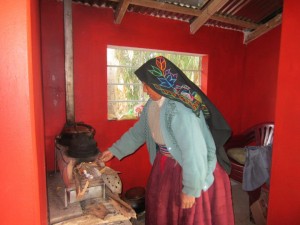Lake Titicaca, Peru: Connecting with culture
Story and Photos by Terri Marshall
As I travel around this fascinating world, connecting with the local culture is always on my agenda. During my recent visit to Peru, I set out to immerse myself in the rural indigenous culture of the small villages on the islands of Lake Titicaca through a tour that included a homestay with a local family – a true adventure.
At 12,507 feet, Lake Titicaca is the highest navigable lake in the world. The lake is shared by Peru and Bolivia – each laying claim to its most picturesque views. On day 12 of a two-week-trip through Peru, I headed to the docks in Puno with my friend, Jill, to board a small and somewhat ragged boat for my next great adventure.
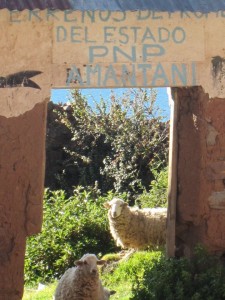
The itinerary called for visits to three destinations on Lake Titicaca. First up were the floating islands of the Uros people. This group of about 40 small islands is home to 2,000 people from the Uros tribe, one that pre-dates the Incan civilization. The islands are built from totora reeds that grow in the lake. The reeds are also used to build their houses, boats and even used as medicine and for substance.
According to Uros legends, the tribe existed before the sun when the earth was still dark and cold. They were impervious to drowning or being struck by lightning. Disobedience to the universal order and mixing with humans cost them their status as super beings and they scattered, losing their identity, language and customs. They became the Uro-Aymaras and now speak Aymara.
Today the remaining natives on the island survive by fishing. Tourism provides most of their income giving the islands a Disney-esque feel, until you remember that you are, in fact, walking around on floating islands made entirely of reeds in the middle of a lake in Peru with a tribe that began from super-human beings.
After a ride in one of the reed boats with the Uros children who serenaded us continually, we said our goodbyes and embarked on a three hour journey to Amantani Island where we would be spending the night with a local family.
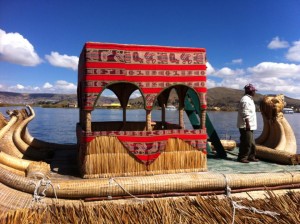
Gladys, a member of our host family, met us at the dock to walk us home – a walk that included a climb up a steep embankment, a hike up several hills and clambering over rocks. Due to the lack of oxygen in an elevation that is the rough equivalent of heaven’s, the walk also included several stops for panting.
Arriving at the home I had one complete moment of bliss when I saw that we not only had indoor toilets, there was even one in our room. The other members of our group had to use outdoor toilets and carry buckets of water for flushing…fate was on our side.
After settling into our room, we joined the family for a simple yet delicious lunch of quinoa soup with potatoes, fried cheese and vegetables. We met Gladys’ mother, Isadora, the children Franklin (11) and Emily (5) and finally the patriarch of the family, Alfredo, who (although we don’t speak the same language) managed to tease me by pointing and panting. Apparently word spreads quickly in the village.
Next on the agenda was a walk up (yes, up again) to the Plaza de Armas to learn about our afternoon options. We put our things away, locked our door then set out to follow Speedy Gonzalez up the path to the plaza.
Afternoon options included: (A) a hike to the top of the island to wait for sunset; (B) a hike up to the next village; or, (C) a stroll around the Plaza de Armas and nearby streets followed by the local drink at the cafe.
Fearing my oxygen deprived body couldn’t handle another hike, I chose option C and enjoyed a leisurely stroll around the village that led to encounters with donkeys, horses, children playing, beautiful vistas and libations.
Amantani Island has limited electricity, no roads and no street lights making the post sunset walk back to the house dark and treacherous. Fortunately, young Franklin arrived with a flashlight to lead the way. About halfway down the hill, Mama Gladys, met us on the path and took away the flashlight leaving us to our own devices.
Back home more trouble awaited when we couldn’t unlock our door. After several attempts, we gave up and asked little Franklin for help. He apparently reported the incident to Mama Gladys who stopped by and took our key away – first our flashlight, then our key? Was she planning to lock us up overnight? There are times when a common language would be very helpful.
We were summoned for a dinner. We started with more quinoa soup, followed by a main course of at least three types of potatoes (Peru has over 3,000 varieties) carrots and other vegetables. The bread was freshly baked from the wood burning stove and I was not about to leave a bite on my plate for fear that Gladys would take away more privileges – toilet paper perhaps?
After dinner we retired to our room and buried ourselves in the five wool blankets covering the bed that must have weighed at least 100 pounds each. Turning over during the night was a bit of a challenge, but the warmth was appreciated.
As morning dawned we were delighted to discover we were not locked in our room, we no longer needed a flashlight and we still had plenty of toilet paper. Gladys even had mercy on us as she walked us back to the dock. She led us to a rock walkway.
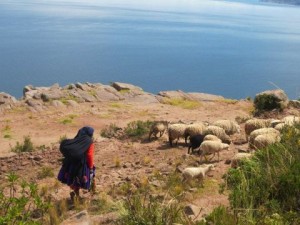
Our final destination on Lake Titicaca was Taquile Island – a UNESCO World Heritage sight known for its fine hand-woven textiles and clothing. Knitting is done exclusively by the males starting at age eight. The women make yarn and weave.
Arriving on the island, we climbed a long narrow path up to the main plaza soaking in stunning views of Lake Titicaca below and Bolivia’s mountain ranges in the distance. The trail winds past ancient agricultural terraces and ruins dating back to pre-Inca times. The Taquile population was relatively isolated from the mainland until the 1950’s and the notion of the community and family is still very strong among them.
The weaving traditions date back to early civilizations and still maintain elements from pre-Inca Andean cultures. The most characteristic of the garments is the “Chullo” – a knitted hat with an earflap. You can determine the marital status of a man by the design of his hat. And, if he is married, he won’t be wearing a wedding band. Instead, when a couple marries, the wife gives her husband a hand-crafted belt to wear with locks of her hair woven throughout.
Perched on an ancient terrace overlooking Lake Titicaca, we savored a typical lunch of vegetable soup, fish (caught from the lake below), rice and a tomato and onion salad.
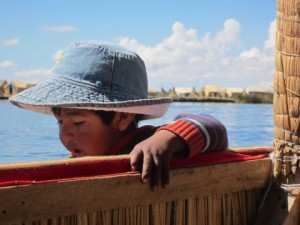
The hike back to the boat required careful navigation of 540 rock steps of varying heights – a descent that ultimately left my quadriceps shaking uncontrollably – but one that also brought us the surreal scene of a village woman in traditional dress herding her sheep.
Each of the islands on Lake Titicaca provided a glimpse into unfamiliar cultures steeped in centuries old traditions the residents are eager to share. The experience, though physically challenging at times, is one I will never forget.
Note: Tour arranged through Condor Travel http://www.condortravel.com/
Terri is a freelance writer with regular columns on travel, chocolate and bar reviews. She is busy each month visiting new places to bring unique travel destinations and events to you. Yes, it is a sacrifice – but she is willing to do that for her readers! You can see more of Terri’s writing at www.examiner.com where she is the National Chocolate Examiner and at www.barzz.net. Also, check out her blog at www.trippingwithterri.com. You can contact Terri at terri.marshall60@gmail.com.



